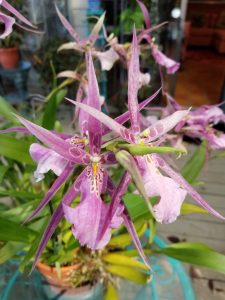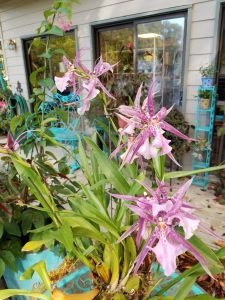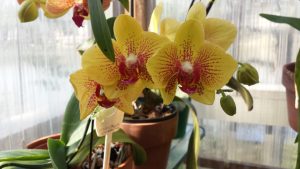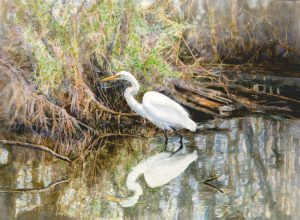 Each time an artist makes a painting they are actually doing something that do not know how to do. At the very least, a portion of the painting needs much thought, and then there other times when more challenge is there than they recognized going into working on it.
Each time an artist makes a painting they are actually doing something that do not know how to do. At the very least, a portion of the painting needs much thought, and then there other times when more challenge is there than they recognized going into working on it.
Periodically you will see a footnote from an artist on a painting reading…”A study of Bluebirds basking in the sun” or “A personal study of rainbows…from a photo taken by…”. So what does this mean?
My interest is in the use of the word “study” on the footnote. Only on artwork have I ever seen this word used in a title…its meaning is to portray that this painting took much study, thinking, deliberating, time, and trying out techniques to see if or how something can be portrayed so the viewer can experience a specific image or feeling that the mind will translate properly, the way the artist would like it to be portrayed or presented. Painting a picture does indeed involve Much deliberation and study to get the Right portrayal. It is not just slapping paint on canvas or paper in 3-6 hours and calling it finished as it would actually be a color sketch or trial. This would be a picture done in paint but it would not be called a painting. In a painting many decisions must be made. Every stroke of the brush directs you down a specific pathway toward completion or screw-up. Every paint brush stroke is a decision for a good or a bad result. Once in a while a poor decision can be corrected for benefit. Learning techniques to correct ones’ mistakes is a must and many mistakes can be repaired in most any medium. In essence, a painting may be 5000-8000 decisions before it is completed depending upon its size. As a painter one must be a Student throughout the entire painting. We as artists actually learn much from each painting.
It takes much time, desire, heart, and energy to “study” and figure out how to get a painting to be the best it can be before an artist is willing to share it with the world. The above painting is one for you to see that involved much study and much time before completion.

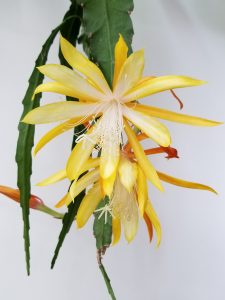 This one just bloomed today! This is a day-booming Epicactus Epiphyllum “Fruhlingsgold” native to Central America. This is an extraordinary tropical succulent cactus or flowering Jungle Cacti, common name “Orchid Cactus”. It is part of a collection of fifteen epicactus of mine and I always tend these semi ugly plants just for the very spectacular, huge, fragrant blooms. Epiphyllums bloom in the spring on 2-3 year old potted plants and off and on during the
This one just bloomed today! This is a day-booming Epicactus Epiphyllum “Fruhlingsgold” native to Central America. This is an extraordinary tropical succulent cactus or flowering Jungle Cacti, common name “Orchid Cactus”. It is part of a collection of fifteen epicactus of mine and I always tend these semi ugly plants just for the very spectacular, huge, fragrant blooms. Epiphyllums bloom in the spring on 2-3 year old potted plants and off and on during the 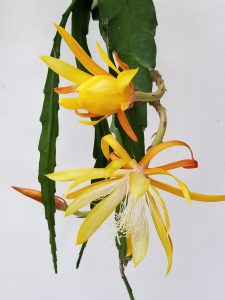 year. This one has been blooming all summer and this bloom opened November 5th. However, the major blooming season for day blooming plants starts in late April, peaks in May and ends in June. During the other months of the year we are rewarded by the occasions “off season” bloom, especially from the 4″ top 2″ varieties.The blooms range from 2″ to 8″in size and the one you see here is 6″ in diameter. Related plants are rattail cacti, rhipsalis, hoyas, Thanksiving-Christmas Cactus, Easter Cactus, and Night Blooming Cereus. They are easy to grow in hanging pots. They need night time temperatures of 45-50 degrees during the winter, where they do not receive artificial light after sundown. This is necessary for bud formation to take place. Their favorite temperatures are 45-70 degrees. In my area they are put outside in part shade and temps in the high 80’s in the summer and in the downstairs up against sliding glass doors with temp 50-70 degrees and seem to do just fine. Repot each spring.
year. This one has been blooming all summer and this bloom opened November 5th. However, the major blooming season for day blooming plants starts in late April, peaks in May and ends in June. During the other months of the year we are rewarded by the occasions “off season” bloom, especially from the 4″ top 2″ varieties.The blooms range from 2″ to 8″in size and the one you see here is 6″ in diameter. Related plants are rattail cacti, rhipsalis, hoyas, Thanksiving-Christmas Cactus, Easter Cactus, and Night Blooming Cereus. They are easy to grow in hanging pots. They need night time temperatures of 45-50 degrees during the winter, where they do not receive artificial light after sundown. This is necessary for bud formation to take place. Their favorite temperatures are 45-70 degrees. In my area they are put outside in part shade and temps in the high 80’s in the summer and in the downstairs up against sliding glass doors with temp 50-70 degrees and seem to do just fine. Repot each spring.